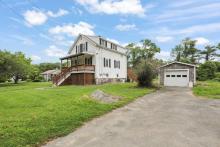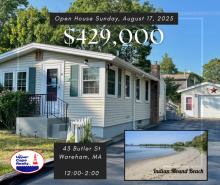Town officials explore alternatives to current sewer fee
Three different models for how the town could charge for sewer usage were presented to town officials on Saturday, June 21.
The public presentation was the second workshop led by Michael Schrader of Tighe and Bond, the Pocasset-based engineering and environmental consulting firm that was commissioned by the town last May to study alternatives to the town's current sewer fee system.
"We're talking about revenues and expenses and trying to get them to balance out," Schrader said.
Schrader presented Selectmen with three options: To keep the current EDU system, to adopt a hybrid model combining a flat fee and a flow-based fee, or to adopt a strictly flow-based fee.
Last week Selectmen set the sewer rate for the next year, maintaining the $596 per EDU fee.
Currently, Wareham sewer users pay a flat annual $596 per EDU (equivalent dwelling units). A single-family home is charged one EDU, while a two-unit duplex is generally charged two EDUs. Businesses are scheduled similarly. For example, restaurants are charged one EDU per 12 seats; gas stations are charged one EDU per service island.
But Schrader has said at previous meetings that the EDU schedule does not properly match up with the actual water use of a property and that only 11 percent of Massachusetts municipalities still use the flat fee system to assess wastewater usage.
Schrader said that in any new system, the big changes are going to be seen by those who use extreme amounts of water.
In the hybrid model, all users from businesses to residents would pay a minimum fee that would cover a majority of sewer department fixed costs (such as labor costs, general plant upkeep and equipment replacement).
Schrader calculated this minimum fee to be $550. He then calculated the additional flow-based fee at $7.50 per hundred cubic feet of water (750 gallons) used above 6,300 cubic feet (roughly 47,250 gallons). The 6,300 number represents the water usage for two-thirds of the users in town.
Schrader said that since wastewater flow is hard to measure and not practical to use for a house, he uses water-use as a surrogate and assumes all water used ends up as wastewater.
"Everyone pays a minimum fee and those who use a lot pay more," Schrader said.
With this method, non-residential users could end up paying significantly less or more depending on their current EDUs.
He displayed a chart showing two users who both use about 636,000 gallons of water per year; one is assessed at 10 EDUs while the other is at 140. The bill for the business at 10 EDUs would skyrocket under a new system. The chart also showed someone assessed at 12 EDUs but only using as much water as a residential home. They would likely see a massive decrease in their bill.
"For people who say the system is fine and working, I leave you to consider this," Schrader said.
In the third model every user pays for every cubic foot of water they use.
Schrader determined that the cost would be $10.93 per hundred cubic feet and said for the average Wareham resident that would translate to $634 per year.
Under this plan, seasonal residents would likely see a major decrease in their bills.
Schrader said if the town chose to adopt a new sewer fee system, the next step would be deciding how to implement the changes to the heavy users.
"How do you do that from the previous year? How do you change one person to go down $20 to $30,000 and one person go up by $15 to $20,000?" Schrader asked. "I don't envy that decision."













